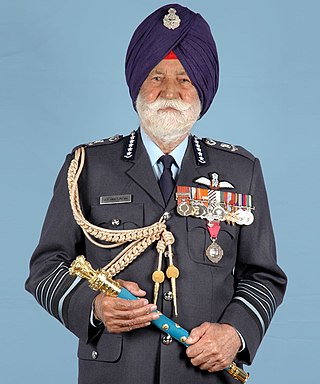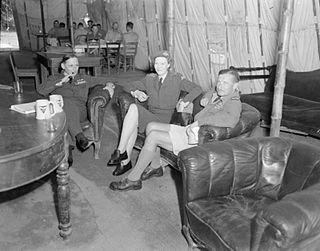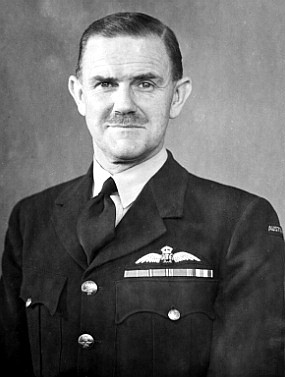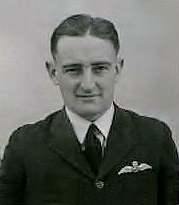
Military ranks are a system of hierarchical relationships, within armed forces, police, intelligence agencies or other institutions organized along military lines. The military rank system defines dominance, authority, and responsibility in a military hierarchy. It incorporates the principles of exercising power and authority into the military chain of command—the succession of commanders superior to subordinates through which command is exercised. The military chain of command constructs an important component for organized collective action.

The Desert Air Force (DAF), also known chronologically as Air Headquarters Western Desert, Air Headquarters Libya, the Western Desert Air Force, and the First Tactical Air Force (1TAF), was an Allied tactical air force created from No. 204 Group RAF under RAF Middle East Command in North Africa in 1941 to provide close air support to the British Eighth Army against Axis forces. Throughout the Second World War, the DAF was made up of squadrons from the Royal Air Force (RAF), the South African Air Force (SAAF), the Royal Australian Air Force (RAAF), the United States Army Air Forces (USAAF) and other Allied air forces.

Air commodore is a senior rank in the air forces of the United Kingdom and other countries including Australia, New Zealand, India, Pakistan and Zimbabwe. It is a one-star rank and is an air officer rank. It originated in, and continues to be used by the Royal Air Force.
Officer Cadet is a rank held by military cadets during their training to become commissioned officers. In the United Kingdom, the rank is also used by members of University Royal Naval Units, University Officer Training Corps and University Air Squadron; however, these are not trainee officers with many not choosing a career in the armed forces.
An air officer is an air force officer of the rank of air commodore or higher. Such officers may be termed "officers of air rank". While the term originated in the Royal Air Force, air officers are also to be found in many Commonwealth nations who have a similar rank structure to the RAF.

No. 12 Group RAF of the Royal Air Force was a group, a military formation, that existed over two separate periods, namely the end of the First World War when it had a training function and from just prior to the Second World War until the early 1960s when it was tasked with an air defence role.
Training Group (TG) of the Royal Air Force was the group that controlled the stations of Personnel and Training Command.

Marshal of the Indian Air Force Arjan Singh, was a senior air officer of the Indian Air Force. He served as the 3rd Chief of the Air Staff from 1964 to 1969, leading the Air Force through the Indo-Pakistani War of 1965. He was the first and only officer of the Indian Air Force (IAF) to be promoted to five-star rank as Marshal of the Indian Air Force, equal to the army rank of Field Marshal.
Air Chief Marshal Sir Charles John Thomson,, usually Sir John Thomson, was a senior officer in the Royal Air Force (RAF).

No. 22 Group Royal Air Force is one of six groups currently active in the Royal Air Force (RAF), falling under the responsibility of Deputy Commander-in-Chief (Personnel) in Air Command. Its previous title up until 2018 was No. 22 (Training) Group. The group is responsible for RAF training policy and controlling the Royal Air Force College and the RAF's training stations. As such, it is the direct successor to Training Group. 22 Group provides training to all three service branches of the British Armed Forces; namely the Royal Air Force, the Royal Navy, and the British Army.

Air Chief Marshal Sir Robert Mordaunt Foster, was a Royal Flying Corps pilot in the First World War, and a senior commander in the Royal Air Force during the Second World War and the immediate post-war years.

The Royal Air Force College (RAFC) is the Royal Air Force military academy which provides initial training to all RAF personnel who are preparing to become commissioned officers. The College also provides initial training to aircrew cadets and is responsible for all RAF recruiting along with officer and aircrew selection. Originally established as a naval aviation training centre during World War I, the College was established as the world's first air academy in 1919. During World War II, the College was closed and its facilities were used as a flying training school. Reopening after the War, the College absorbed the Royal Air Force Technical College in 1966.

Air Marshal Sir Richard Bowen Jordan, was a bomber pilot and squadron commander during the Second World War, a senior Royal Air Force officer during the post-war years and the sixth Commandant of the Royal Observer Corps (1949–51).

Air Marshal Sir Alister Murray Murdoch, was a senior commander in the Royal Australian Air Force (RAAF). He served as Chief of the Air Staff (CAS) from 1965 to 1969. Joining the Air Force in 1930, Murdoch trained as a seaplane pilot and participated in an Antarctic rescue mission for lost explorers in 1935. During World War II, he commanded No. 221 Squadron RAF in Europe and the Middle East, and later occupied senior positions on the staff of RAAF formations in the South West Pacific. His post-war appointments included Commandant of RAAF College from 1952 to 1953, Air Officer Commanding (AOC) Training Command from 1953 to 1955, Deputy Chief of the Air Staff from 1958 to 1959, and AOC Operational Command from 1962 to 1965.

Air Vice-Marshal Francis Masson Bladin, was a senior commander in the Royal Australian Air Force (RAAF). Born in rural Victoria, he graduated from the Royal Military College, Duntroon, in 1920. Bladin transferred from the Army to the Air Force in 1923, and learned to fly at RAAF Point Cook, Victoria. He held training appointments before taking command of No. 1 Squadron in 1934. Quiet but authoritative, he was nicknamed "Dad" in tribute to the concern he displayed for the welfare of his personnel.

Air Vice Marshal Ian Dougald McLachlan, CB, CBE, DFC was a senior commander in the Royal Australian Air Force (RAAF). Born in Melbourne, he was a cadet at the Royal Military College, Duntroon, before joining the Air Force in December 1930. After serving in instructional and general flying roles, he took command of No. 3 Squadron in December 1939, leading it into action in the Middle East less than a year later. Awarded the Distinguished Flying Cross, he returned to Australia in 1942 to command air bases in Canberra and Melbourne. The following year he was posted to the South West Pacific, where he led successively Nos. 71 and 73 Wings. Having been promoted to group captain, he took charge of Southern Area Command in 1944, and No. 81 Wing in the Dutch East Indies the following year.

An officer is a person who holds a position of authority as a member of an armed force or uniformed service.

Air Vice Marshal Frank Headlam, was a senior commander in the Royal Australian Air Force (RAAF). Born and educated in Tasmania, he joined the RAAF as an air cadet in January 1934. He specialised in flying instruction and navigation before the outbreak of World War II. In April 1941, he became commanding officer of No. 2 Squadron, which operated Lockheed Hudsons. The squadron was deployed to Dutch Timor in December, and saw action against Japanese forces in the South West Pacific. After returning to Australia in February 1942, Headlam held staff appointments and training commands, finishing the war a group captain.
At the end of the Cold War in 1989, the Royal Air Force (RAF) structure was as follows:

Air Marshal Harvey Smyth, is a senior Northern Irish Royal Air Force officer, who currently serves as the Air and Space Commander. From July 2018, he served as Air Officer Commanding No. 1 Group. Between February 2020 and August 2022, he took up the new post of Director Space, in the Ministry of Defence.














